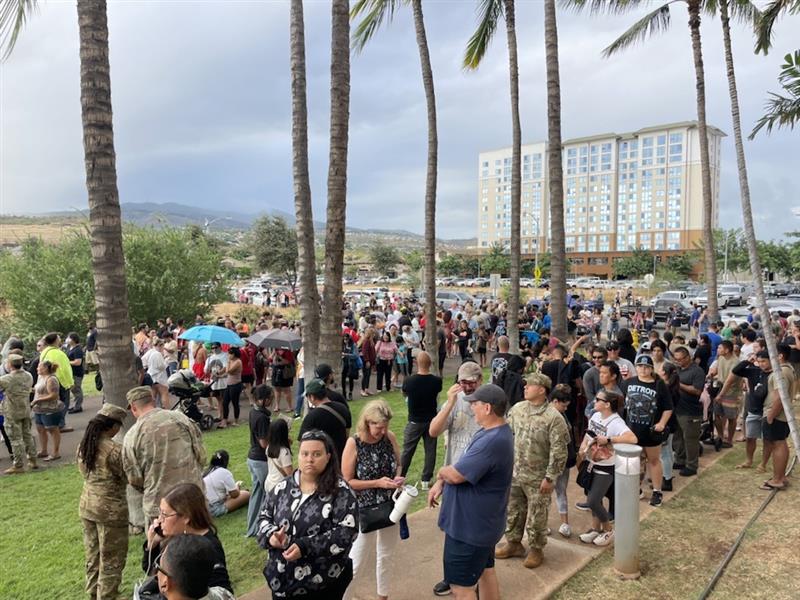HONOLULU (KHON2) — Thousands of voters across Hawaii faced long lines on Election Day, with some in West Oahu waiting up to six hours to cast their ballots. At locations like Honolulu Hale and Kapolei, frustration grew as voters endured hours of waiting to fulfill their civic duty.
“That’s the only time I had time, the only day I had time,” said Adrienne Mauai, a voter at a local election headquarters.
“It sucks, but we want to vote. We want our vote to count,” said Tiane Marciél, another voter.
On Tuesday, voters joined tens of thousands across the Hawaiian Islands who opted to vote in person, including more than 22,000 on Oahu and nearly 3,500 on Kauai. In total, nearly 40,000 people voted in person, with more than 15,000 casting their ballots on Election Day alone.
“I’ve been standing up all day, so what’s a couple more hours being able to do your civic duty?” said Cory Haines, another voter.
“It’s a little frustrating. But you know what? Now that we’re at the end, I’m excited,” said Beverly Ani, who finally cast her vote late Tuesday evening.
The last in-person ballot was cast just after midnight, marking the close of a marathon day for election officials and voters alike. However, the long waits have raised concerns among lawmakers and voters, many of whom say the process needs reform.
House Minority Leader Diamond Garcia expressed frustration with the long lines, saying, “A lot of people walked out of line because it was way too long, five, six-hour waits. That is ridiculous. It is unacceptable.”
When asked about solutions to reduce wait times for future elections, election officials acknowledged the challenges.
“We’re going to do an after-action review and take a look at all of our options,” said Glen Takahashi, Hawaii’s chief election officer. “But you’re only as good as your site that is going the slowest. So even if we ran five sites, we could still have one that had to go until midnight, and we’d be in the same place.”
Maui County Clerk Moana Lutey added that more education might help voters better understand why waits are so long. “Is it a matter of more education, so people understand that this was not COVID-related? Because unfortunately, those seem to coincide,” she said.
Scott Nago, the state’s Elections Division Administrator, noted that many delays stemmed from people updating their voter registration at the service centers rather than beforehand. “Voter education, letting people know that they should update their voter registration before going to the Voter Service Center, could have helped speed up the process,” Nago said.
However, some voters, especially those who prefer in-person voting, bristled at the suggestion that the public needed to adapt.
“Allow me to educate you as an African American male whose ancestors fought, died, and were tortured for the right to vote in person,” said Camron Hurt, a voter rights advocate with Common Cause Hawaii. “I deserve to have as many options to vote as possible, and so do all my kama’aina residents here in the state.”
Lawmakers and voter rights advocates are calling for changes to improve the voting process. Garcia, who reintroduced a bill last year to expand the number of polling places, vowed to continue pushing for reform.
“We, the people, are not going to stand by and let this happen again,” Garcia said.
While the state’s transition to a vote-by-mail system was expected to save the state money, the cost of elections has actually risen. According to a recent review by Always Investigating, Hawaii’s elections have cost $1.5 million to $2 million more than originally projected, with savings of $750,000 a year not yet realized.
Lutey noted that opening additional polling places could help reduce wait times, but at a significant cost. “It’s significant, but it’s also very difficult to staff,” she said. “We had a really hard time staffing this time, and I don’t think we’re alone. So getting that manpower and funding seems contradictory to what the legislature hoped to achieve by switching to vote-by-mail.”
Despite the goal of boosting voter turnout, participation in Hawaii’s elections has remained stagnant, with overall turnout in the 50 to 60 percent range for presidential elections. However, the number of people voting in person on Election Day has surged.
Critics argue that if in-person voting were made more accessible, turnout could increase even further. “How many more might have voted if the system wasn’t so inconvenient?” said Hurt.
The trend was seen not only on Oahu but also on Maui and Hawaii Island, where in-person voting surged in the final days.
“Come the 5th, Wailuku had a long line that stretched out toward the baseball park,” Lutey said. “The wait was over an hour for some people, and we ended up closing around 10 p.m. on Election Day.”
Election officials are considering how to balance the needs of voters with the costs of running a robust election system. Nago emphasized that staffing and managing multiple locations could still result in delays, as lines could form at the most popular sites. “All it takes is one popular Voter Service Center, and you’ll still have a line,” Nago said.
As election officials look ahead, lawmakers and advocates alike are urging for a more efficient, equitable system to ensure that all voters have a fair and timely opportunity to cast their ballots.
